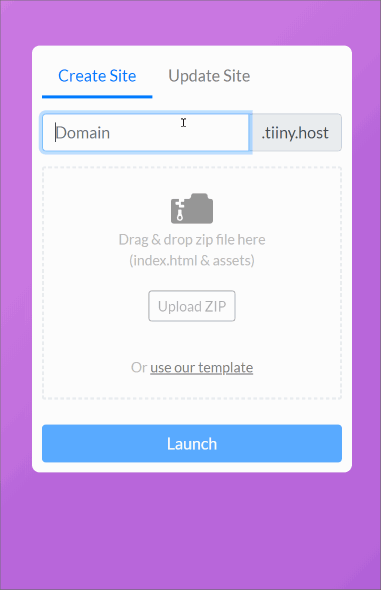
TL;DR
We launched with minimal features. Our landing page encouraged users to try our tool straight away. We marketed to many different platforms. We listened to our early users and built a Pro plan accordingly. We began a content marketing strategy and then listed on Product Hunt.
Last week we hit our biggest milestone to date. We earned our first dollars. It’s a milestone which many products go without. A milestone which many start-ups go without.
I encourage every product to reach it as soon as possible because it’s a pivotal point in every product’s lifetime. It’s a significant point of idea validation and in all honesty, there were times we thought we’d never get there.
But we did, and for all of you on your own journey out there, here are some lessons we learned:
Allow visitors to play with your product as soon as possible

From the get-go, we built tiiny.host to be as simple and straightforward to use as possible. We had no “landing page” per se, and rather than building a marketing page to communicate our product’s feature set, we encouraged our visitors to try the product out themselves - without the need to even register. In fact, this was the only thing you could do on our site.
This resulted in the shortest possible time between landing on our website and experiencing value from our product. Visitors witnessed their site live on the internet in literally seconds.
We actually only got this right in the second version of our product. The very first version of the product meant the user had to wait for 15–20 mins for their site to be available on the web.
We also realised early on that many visitors may not have a set of static web files handy to upload but still wanted to test us out. So, we added an option to use a template. This resulted in huge increase in the number of new sites created and is now the primary route new visitors try tiiny.host.
Of course, this may not be possible for all types of products. Complex SaaS products for example may need tutorials and configuration for a user to experience value. However, I encourage you think about extracting key features from behind your registration wall and place them on your landing page instead.
Today the web is full of illustrated landing pages. Some are for products that don’t even exist yet. If you’ve actually invested the time in building a product then let as many people as you can play with it.
Cast a wide net
Following our launch, we didn’t exactly know who our target audience would be. We had a hunch, but with no real users this was not validated. So, we cast a wide net and marketed to many major platforms in a sensible way.
Here’s a great list to get you started. These included Indie Hackers, YouTube, Twitter, Reddit and Slack groups. Its’ very important to not spam these communities but engage with them on their own terms.
For example, Redditors love freebies and giving feedback on new products. There are specific subreddits which are great for this and as a thank you we chucked in promocodes for 100% off the premium version of tiiny.host. This got us our first few hundred users.
For YouTube, we’re creating tutorials for junior developers but also connect with tiiny.host.
Slack groups are the hidden gems of the world today. They’re like speakeasies - you can only be invited into them but once you’re in there’s a super supportive community of early users.
We even engaged with the Open Source community through GatsbyJs.
Engage with your early users - they’re the most important users you’ll ever have
We deliberately launched with a minimal but widely applicable feature set. We also didn’t have a paid plan. This allowed us to analyse early on who used tiiny.host and why. We actually formulated our Pro plan and feature set through conversations with our users.
Slack communities are perfect for this. We found a really helpful user early on who loved using our product for a use case we didn’t event realise existed. We wrote a blog post to teach others.
Another fan sent us this amazing email that - 1. Boosted our morale 2. Highlighted yet another use case we didn’t even realise existed. He’s a teacher and used tiiny.host to upload slides created using a markdown library to tiiny.host.
You’ve probably heard this countless times before, but it’s said for a reason. Speaking to your users really is one of the most important things that you need to do early on.
Add a paid plan early on but don’t sell your product short
We introduced a paid plan three months later based upon initial user feedback. We built out features early users requested, but then released them only for our Pro plans. This saved us from building features for a paid plan that nobody wanted to buy.
We tried to not sell ourselves short by pricing the product higher than we thought we should charge. It’s natural to undervalue your product especially because its new and maybe buggy. But the fact is that perceived value is directly correlated with the price of your product.
A low-priced product is generally perceived as low-value. A high-priced product, quite the opposite. A customer buying your product at a high price is better validation of your value proposition than a customer buying your product at a cheaper price. You can always re-calibrate your prices later.
I heard of one product that doubled their price every time someone made a purchase. New paying customers still continued to come in through the door.
Promocodes are also a great way of teasing the market. Everyone loves an bargain. For our Product Hunt launched we offered 50% off our Pro plans which resulted in our first sale! Our second sale paid us full price. Gumroad is a great product for payment and promo-code integration.
Work on both your short- & long-term marketing game
We’ve come to realise that there are essentially two avenues in growth hacking and marketing:
1. Short-term marketing - Short spikes of visitors through sharing your product on popular platforms like Hacker News, Product Hunt or Indie Hackers.
2. Long-term marketing - Slow, cumulatively growth through SEO targeting and content marketing strategies. These include blogging, video tutorials and engaging with relevant communities such as Quora & Reddit.
It’s really important to work on both avenues. Yes, you can quickly get attention from sites like Product Hunt but you’ll always see steep drops after it lists. However, these are great for general morale and usage boosts at the right time.
Long term strategies cement your product on the internet. We’re now cemented on Gatsby’s website and starting to see us rank for relevant keywords.
Market your marketing material
Lastly, we’ve learnt to market all of our marketing materials. Our Product Hunt launch started with us hidden from the Front Page. We then shared our post to our network (Twitter, WhatsApp, Slack, Indie Hackers etc.) and gradually saw ourselves climb the ranks to the Front Page and 1500+ visitors.
If we had just posted and left our listing to be, we’d have likely been buried.
In our modern web, content easily gets lost - no matter how great it is. Aim to squeeze every last drop of juice out of each blog post or listing.
What’s next?
We’re definitely going to focus on more long-term marketing and look for short-term bursts along the journey.
Our Pro plans are still very new so we’re really trying to understand what form our product generate most value.
Ps. Shameless plug 😉, here’s a promocode for 30% off our Pro plans if you’re interested: “blog30”


